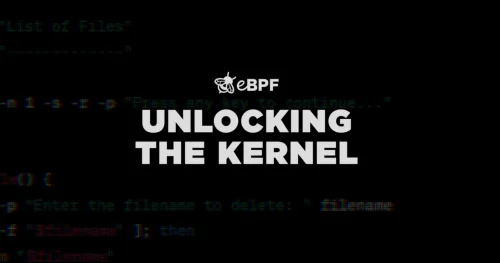Blog page

eBPF and OpenTelemetry Rule At KubeCon 2023 in Chicago: Observability Is King
A rundown of eBPF and OpenTelemetry presence at KubeCon NA 2023 in Chicago
Read more
Beginner's Guide to XDP: A Journey Through Crafting XDP-Based Firewall with BCC
Dive into the fundamental procedures and actions for interacting with packets efficiently by crafting a simple, functional XDP application
Read more
Documentary Film “eBPF: Unlocking the Kernel” Reveals the Unfolding Revolution of eBPF
Business Wire reports on the release of the eBPF documentary film at KubeCon + CloudNativeCon North America 2023 by Speakeasy Productions
Read more
eBPF Documentary: eBPF’s Creation Story – Unlocking The Kernel
Thomas Graf highlights some important milestones that occured during the creation and evolution of eBPF. This article serves as a guide for the recently released eBPF documentary
Read more
CoreTechnologys - How to drop 1 Tbps of DDoS traffic
Discover how CoreTechnologys tackled a DDoS attack using eBPF/XDP-powered hardware to efficiently filter out malicious traffic at their network's edge
Read more
KubeCon points to the future of enterprise IT
Explore the strategic shifts in enterprise IT at KubeCon, highlighting the significance of open-source projects like eBPF/Cilium and Tetragon in shaping cloud infrastructure and enhancing security in distributed computing
Read more
How to Use eBPF Capabilities to Navigate Kubernetes Monitoring
Learn how eBPF can be used to elevate your Kubernetes monitoring strategy by setting up an eBPF environment to monitor Kubernetes
Read more
The Big Interview: Thomas Graf, CTO, Isovalent, on eBPF, cloud-native networking and why Cilium is so hot right now
The Stack features Thomas Graf, CTO of Isovalent, discussing Cilium, an ebpf-based project for cloud native networking. Thomas highlighted Cilium's impact on cloud native networking, noting its rapid ascent as an eBPF-based standard for secure Kubernetes networking
Read more
Why eBPF Isn’t Enough for Container Monitoring
This article discusses how eBPF falls short for container monitoring because it doesn't capture application-level activity or the broader context necessary for a complete network observability strategy
Read more
When Not to Use eBPF for Observability and Security
Dive into eBPF's capabilities for system observability and security on Linux systems, while noting its limitations, like the lack of Windows support and the complexity of eBPF programming, which requires deep Linux kernel knowledge
Read more